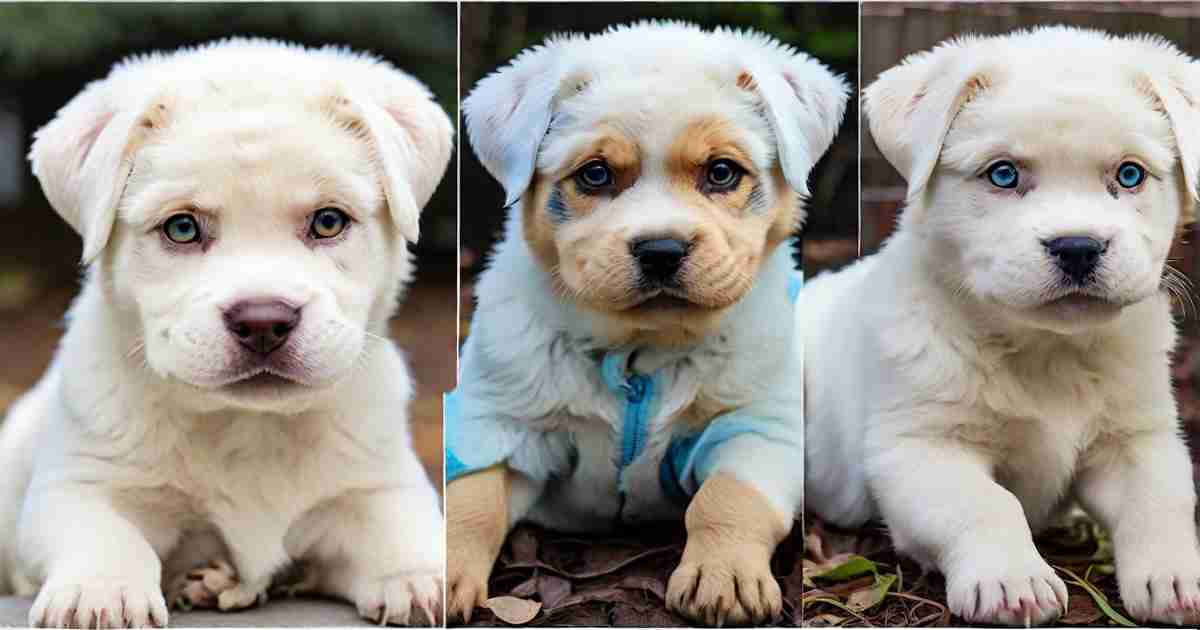The uncommon and mystical albino blue rottweiler has captured the fascination of dog lovers around the arena. With their placed icy blue eyes and snowy white coats, these ghostly pups appear to be something directly out of a fairytale.
However what exactly are albino blue rottweilers? Where do they arrive from? And are they simply as loving and loyal as their more commonplace black and tan cousins?
In this extensive guide, we’ll dig into the genetics, temperament, fitness issues, and origins of this extraordinarily rare color variant of absolutely everyone’s preferred guard canine breed.
You’ll study whether or not albinism impacts conduct, if they make desirable family pets and the way their stunning white coats emerge as. So snatch a relaxed seat and get ready to explore the spell-binding global of the albino blue rottweiler!
What is an Albino Blue Rottweiler?
An albino blue rottweiler is a very rare variation of the Rottweiler breed characterized by a white coat, pink skin, nose and paw pads, and icy blue eyes due to a lack of pigmentation.
This is caused by a genetic mutation that prevents the dog’s body from producing melanin, the pigment responsible for coat, eye, and skin color in dogs.
While sometimes referred to as just “blue Rottweilers”, true albino blue Rottweilers lack all dark pigment and will have bright pinkish eyes, nose, lips, and toenails. They may also be more sensitive to sunlight.
Key Takeaways:
- Albino blue Rottweilers have a white coat, pink skin, nose, pads, and blue eyes due to a lack of melanin pigment.
- Not to be confused with the albino blue rottweiler, which retains some pigment. Albinos lack all dark pigment.
- Caused by rare genetic mutation preventing melanin production.
Albino Blue Rottweiler Genetics
The genetics behind albino blue Rottweilers and other albino dogs is relatively simple – it all comes down to a mutation in a gene called tyrosinase. This is an enzyme vital to melanin production in dogs.
For a Rottweiler puppy to be born albino, two things must happen:
- Both parents must carry the recessive albinism gene
- The puppy must inherit two copies of the mutated albinism gene, one from each parent
Because the gene is recessive, both parents can carry it hidden without any outward symptoms. But when two carrier dogs breed, approximately 25% of the litter will inherit the double recessive genotype and be born albino.
Many believe albino Rottweiler litters are the result of inbreeding, which increases the chances of rare recessive traits appearing. Reputable breeders do not intentionally breed for albinism due to associated health issues.
Key Takeaways:
- Albinism is caused by a recessive genetic mutation in the tyrosinase gene
- Pups inherit mutated genes from both parents
- Parents can carry genes without symptoms
- Inbreeding increases the chances of trait appearing
- Reputable breeders do not intentionally breed albino dogs
Appearance of Albino Blue Rottweilers
The most striking feature of an albino blue Rottweiler is their purely white coat and light blue or pinkish eyes. They will have no black pigment on the nose, paws, lips, or eyelids. The lack of melanin pigment even shows on albino puppies at just a few days old.
Some key ways to identify albino blue Rottweilers:
- Pure white coat with no tan markings
- Pinkish eyes, nose, lips, pads, and toenails
- No dark pigment on eyelids, lips, or nose
- Light sensitivity is common
- Blue eyes as a puppy may fade to pink as an adult
Other than pigmentation, albino blue rottweilers are structurally very similar to a normal Rottweiler. They have the same strong, sturdy build and broad head. White coats may have a sleeker, softer texture than black and tan coats, which are more dense.
Albino traits remain fixed – the dog’s white coat and light eyes are permanent. The pigment will not darken as the dog matures.
In summary, the lack of melanin pigment is the only difference in appearance between an albino and a normal Rottweiler.
Temperament and Behavior
Prospective owners often wonder if albinism affects a Rottweiler’s behavior and temperament. The good news is albino blue Rottweilers have the same temperament as their black and tan counterparts!
These loyal, affectionate dogs still make devoted companions and excellent guard dogs. Albinism is only a cosmetic difference – it does not directly alter personality or mental ability.
However, experts do recommend extra socialization and training for albino pups. This is due to the fact they’re regularly under-socialized through breeders because of their sensitive health and high cost.
Thorough training ensures they grow into confident, nicely-adjusted adult dogs. Moreover, their uncommon look every so often draws unwanted interest in the public. Right education permits them to deal with this in a composed manner.
With good socialization and handling, an albino blue rottweiler from healthy lines should have a stable temperament. They display the same intelligence, trainability, and desire to please as any well-bred Rottweiler.
In summary:
- Albinism does not directly affect personality or temperament
- Trainability and loyalty equivalent to normal Rottweilers
- Extra socialization is recommended to support the development
- Well-socialized albino Rotties make wonderful family pets
Health and Lifespan of White Rottweilers
Unfortunately, many issues come along with the lack of melanin inherent to albinism. Albino dogs of any breed are prone to certain health problems, especially vision and skin-related.
Some key health concerns to be aware of with albino Rottweilers:
- Vision defects – Significant vision loss/blindness is common
- Photophobia – Extreme light sensitivity and eye pain
- Hearing loss – Lack of pigment associated with deafness
- Skin cancer – High risk of sunburns and skin cancer
- Allergies – More allergy issues than pigmented dogs
Other conditions like heart defects, seizures, and other neurological issues may also appear. Eye problems tend to show up early in life.
Veterinary experts do not recommend intentional breeding of albino blue rottweilers, as doing so perpetuates these health issues. Ethical breeders will not produce deliberate litters.
Unfortunately, albino blue Rottweilers often have a shortened life expectancy, sometimes living only 6-8 years rather than the typical 8-11 year Rottweiler lifespan. Providing diligent health care and lifestyle adjustments can help maximize their quality of life.
Origin and History
The very first albino blue Rottweiler on record was born in 1997 in a litter of genetically diverse German Rottweilers. The pup was likely the result of a spontaneous genetic mutation and extensive inbreeding in his pedigree.
This rare pup was purchased and resold multiple times for increasingly exorbitant prices due to his novelty. Breeders saw an opportunity to profit from producing more albino dogs.
Through selective inbreeding of his offspring and other attempts to recreate the mutation, more albino blue rottweilers were born.
Today, their rarity still commands hefty prices. Sadly, puppy mills and irresponsible breeders trying to cash in will often inbreed dogs to produce albino litter.
Reputable breeders avoid knowingly breeding albino bloodlines due to health and longevity concerns and focus on improving the breed. But albino Rottweilers themselves typically make wonderful pets with the right care.
Finding an Albino Blue Rottweiler Puppy
Locating a responsible albino Rottweiler breeder can prove very difficult. Our best advice is to be extremely cautious of anyone advertising these dogs.
Intentional albino breeding is universally condemned by ethical Rottweiler breed clubs and should never be supported. Breeders that seem focused on producing albino litters frequently operate unethically.
However, on very rare occasions albino pups are born naturally in litters from healthy lines. If seeking an albino companion, these are the only circumstances where adoption is recommended.
Expect health testing documentation for both parents, a conversation about associated risks, and no profit-motivated breeding.
Adoption is also a possibility if an albino Rottie ends up in a shelter or rescue, but these dogs are quite scarce in the adoption system. Working with a respected Rottweiler-specific rescue is advisable over a general shelter.
Patience is key – it may take months or years for an albino puppy or dog to become available from a responsible source. If the right albino blue rottweiler comes along, they can make marvelous, unforgettable companions!
Frequently Asked Questions
Still have questions about these mystical white dogs? Check out some common queries below:
Are albino Rottweilers rare?
- Extremely! Only a handful are born each year worldwide. Their ghostly white appearance occurs very infrequently absent intensive inbreeding.
What health issues do albino Rottweilers have?
- Severe vision problems, light sensitivity, skin cancer risk, allergies, deafness, heart conditions, and neurological disorders. Responsible breeders do not produce albino dogs intentionally due to health risks.
Do albino Rottweilers make good pets?
- Yes, with proper training and care, albino Rottweilers have superb temperaments and make incredibly devoted companions. But their extensive health needs must be accounted for.
How long do albino Rottweilers live?
- Unfortunately only 6-8 years on average, compared to 8-11 years for normal Rottweilers. Their health concerns result in a shortened lifespan.
Can a normal Rottweiler have albino puppies?
- Extremely unlikely – both parents must carry the recessive albinism gene. Unless there’s albino ancestry, two normal-appearing Rotties will practically never produce albino pups.
Conclusion
From their magical snowy coats to their shining mild eyes, albino blue Rottweilers captivate dog lovers internationally with their otherworldly beauty.
However, their genetic strong point comes at a value – these puppies face big fitness and imaginative and prescient demanding situations proscribing their lifespan.
At the same time as their temperament and trainability continue to be unchanged from traditional Rottweilers, dedicated proprietors should element within the tremendous care albino pups require. Supporting disreputable breeders that deliberately produce litters is also never advised.
Rarity always results in mystique, but albino blue rottweilers pay a dear price. Our greatest hope is that through education and advocacy, their intentional propagation will come to an ethical end.
If the occasion arises to adopt one of these marvelous white canines, may the experience bring both human and dog joy beyond measure.










1 thought on “The Mystical Albino Blue Rottweiler: A Complete Guide”